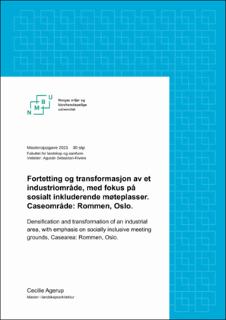| dc.contributor.advisor | Sebastian-Rivera, Agustin | |
| dc.contributor.author | Agerup, Cecilie | |
| dc.date.accessioned | 2021-10-04T12:31:35Z | |
| dc.date.available | 2021-10-04T12:31:35Z | |
| dc.date.issued | 2021 | |
| dc.identifier.uri | https://hdl.handle.net/11250/2787499 | |
| dc.description.abstract | Den bærekraftige utviklingen står sentralt i dagens by- og tettstedsutvikling i Norge, hvor en fortetting av eksisterende byer har blitt svaret på å utvikle byer på en bærekraftig måte.
I den bærekraftige utviklingen skal de tre bærekraftsdimensjonene, de sosiale, miljømessige og økonomiske aspektene, balanseres opp mot hverandre. Ved en fortetting av byene, innenfor bygrensen, verner man om de større grøntområdene utenfor bygrensen. Ved en høy tetthet skapes det kortere avstander mellom byens målpunkter, noe som reduserer behovet for bilen i hverdagen. Disse tiltakene fremmer den miljømessige og økonomiske dimensjonen, ved vern av natur, redusert bilbruk og høyere arealutnyttelse. Det viser seg derimot at fortettingen har ført til negative konsekvenser for bomiljøet i byen, hvor fokuset på høy arealutnyttelse, har ført til nedbygging av byrom og grøntområder. Som et resultat har det sosiale livet i byen blitt svekket. Spenningen mellom de tre dimensjonene viser seg som en sentral konflikt i den bærekraftige byen, som ennå ikke har blitt løst.
Byrommene er sentrale elementer for å skape og opprettholde et sosialt liv i byen. Det er her, i rommene mellom husene, at møter mellom mennesker kan oppstå, noe som skaper et grunnlag for et yrende byliv. For å fremme det sosiale livet i byen er det dermed sentralt å ha et fokus på byens rom, og de felles møteplassene utendørs.
I oppgaven undersøker jeg hvilke konsekvenser konflikten mellom de tre bærekraftsdimensjonene har for det sosiale livet i byen. I prosjekteringen av caseområdet, Rommen i bydel Stovner, viser jeg hvilke fysiske tiltak som vil fremme det sosiale livet i byen, med åpne og tilgjengelige møteplasser, hvor fortettingen av området gjøres med et fokus på kvalitet.
Oppgaven avsluttes med en diskusjon rundt landskapsarkitekters rolle i å fremme det sosiale livet i byen, og hvordan man i større grad kan fremme sosialt inkluderende møteplasser i byen i en fortettingsprosess. | en_US |
| dc.description.abstract | The compact city is central in todays urban development in Norway, where a densification of excisting cities have become the answer to developing cities in a sustainable way.
In the sustainable development, the three sustainable development goals, the social, economical and ecological, should be balanced against each other. With a densification of the cities, within the city limits, the large green areas outside of the city limits will be shielded, where a high density creates a shorter distance between the target points of the city, and reduces the need of the car in the weekdays. These measures promotes the ecological and economical dimensions, with the protection of large nature areas, by reducing the car use, and with higher land use. It turns out, however that the densification has led to negative consequences for the living environment in the city, where the focus on high land use has led to a downsizing of the open city spaces and green areas inside of the city limits. As a result the social life in the city has been weakened. The tension between the three dimensions has shown itself as a central conflict in the sustainable city, that has yet to be solved.
The public space of the city are central elements of creating and mantaining a social life in the city. It’s here, in the space between the buildings, that encounters between people can occur, which creates a foundation for a bustling city life. To promote the social life in the city it is central to have a focus on the urban space of the city, and the common meeting places outdoors.
In the thesis I examine what consequences the conflict between the three sustainable development goals, have for the social life in the city. In the engineering of the case area, Rommen in the district of Stovner, I show what type of physical measures will promote the social life of the city, with open and accessible meeting places, where the densification of the area is done with a focus on quality.
The thesis ends with a discussion around the role of landscape architects in promoting the social life in the city, and how one in a larger degree can promote socially inclusive meeting places in a densification process. | |
| dc.language.iso | nob | en_US |
| dc.publisher | Norwegian University of Life Sciences, Ås | en_US |
| dc.rights | Attribution-NonCommercial-NoDerivatives 4.0 Internasjonal | * |
| dc.rights.uri | http://creativecommons.org/licenses/by-nc-nd/4.0/deed.no | * |
| dc.subject.other | Norway, Oslo, Stovner, Rommen | |
| dc.title | Fortetting og transformasjon av et industriområde, med fokus på sosialt inkluderende møteplasser : caseområde: Rommen, Oslo | en_US |
| dc.title.alternative | Densification and transformation of an industrial area, with emphasis on socially inclusive meeting grounds : casearea: Rommen, Oslo | en_US |
| dc.type | Master thesis | en_US |
| dc.description.localcode | M-LA | |

